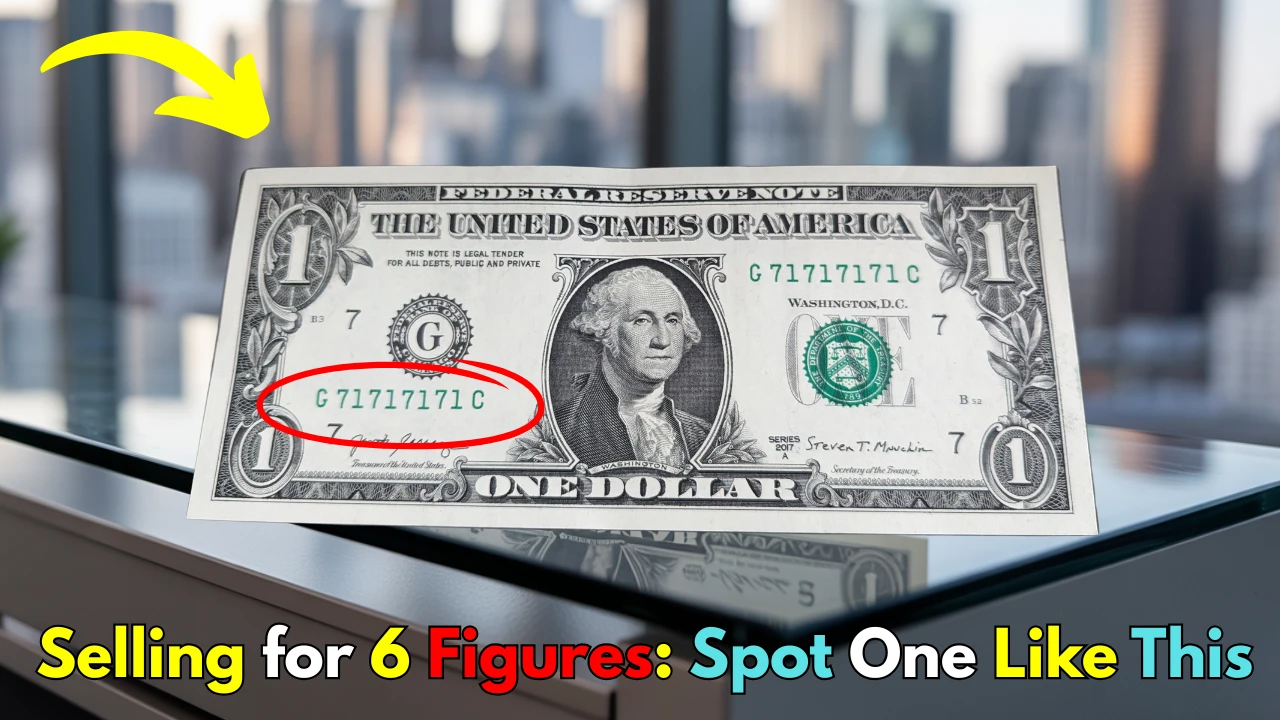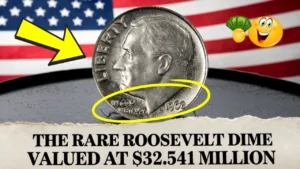Imagine pulling a crumpled dollar bill from your wallet and discovering it’s worth more than your car—or even your house! For coin and currency collectors, this dream is closer to reality than you might think, especially when it comes to repeater serial number $1 silver certificates from 1935. These rare pieces of U.S. paper money, once used as everyday cash, are now fetching six figures at auctions.
Why are these bills so special? How can you spot one? And could you already have a fortune tucked away in a drawer? In this post, we’ll dive into the fascinating world of rare coins and valuable coins, uncovering the allure of these unique silver certificates and how you can join the hunt for numismatic treasures.

What Are Repeater Serial Number $1 Silver Certificates?
A silver certificate is a type of U.S. paper currency issued between 1878 and 1964, backed by silver held in the U.S. Treasury. Unlike today’s Federal Reserve Notes, these certificates could be exchanged for silver coins or bullion, making them a tangible link to the nation’s bimetallic monetary system. The 1935 $1 silver certificate is one of the most iconic, featuring George Washington’s portrait and the famous “All-Seeing Eye” pyramid on the reverse—a design still seen on modern dollar bills.
What makes certain 1935 silver certificates extraordinary is their serial number. A repeater serial number is a pattern where the digits repeat in a sequence, like 12341234 or 45454545. These “fancy” serial numbers are rare because they were printed randomly, not intentionally, by the Bureau of Engraving and Printing (BEP). When combined with the historical significance of silver certificates, a repeater serial number can transform an ordinary dollar bill into a collector’s holy grail.

Key Features of 1935 $1 Silver Certificates
- Design: George Washington on the front, Great Seal with pyramid and eagle on the back.
- Blue Seal: Indicates it’s a silver certificate, not a standard dollar bill.
- Serial Number: A unique 8-digit number (with prefix/suffix letters) printed in blue ink.
- Star Notes: Some certificates have a star symbol in the serial number, marking them as replacements for misprinted notes, often increasing value.
The History of 1935 $1 Silver Certificates
To understand why these bills are so sought after, let’s travel back to the 1930s. The U.S. was in the grip of the Great Depression, and the government was navigating a complex monetary landscape.
The Bland-Allison Act of 1878 had introduced silver certificates to support the silver industry, allowing people to deposit silver coins at the Treasury in exchange for paper certificates. By 1935, the silver certificate was a staple of American currency, with the 1935 series marking a pivotal design shift.
The 1935 $1 silver certificate was the first to feature the now-iconic reverse design, including the “All-Seeing Eye” above a pyramid and the Great Seal’s eagle.
Signed by Treasurer William A. Julian and Secretary of the Treasury Henry Morgenthau Jr., these notes were printed in massive quantities, making most examples common today. However, certain varieties—like those with repeater serial numbers or star notes—are exceptionally rare due to the random nature of serial number assignments.

A Snapshot of the Era
- Economic Context: Issued during the Great Depression, these bills circulated heavily, with few collectors preserving them.
- Bimetallic Standard: Silver certificates reflected the U.S.’s brief return to a bimetallic (gold and silver) monetary system under the Bland-Allison Act.
- Design Influence: President Franklin D. Roosevelt personally suggested elements of the 1935 reverse design, cementing its place in history.

Why Are Repeater Serial Numbers So Valuable?
The value of a repeater serial number $1 silver certificate lies in its rarity and appeal to collectors. Here’s why these bills can fetch six figures:
- Scarcity: Repeater serial numbers are a fluke of the printing process. With millions of 1935 silver certificates printed, only a tiny fraction have repeating patterns like 12121212 or 55555555.
- Collector Demand: Coin collecting and currency collecting enthusiasts prize unique serial numbers, especially “super repeaters” (e.g., 45454545) or “solid” numbers (e.g., 88888888).
- Condition Matters: Notes in uncirculated or gem condition (graded MS-65 or higher by services like PCGS or PMG) command the highest prices.
- Historical Significance: As relics of the U.S.’s silver-backed currency era, these certificates are tangible pieces of financial history.
- Auction Fever: High-profile auctions, like those at Heritage Auctions, drive up prices for rare notes, especially when paired with a star symbol or error.

Common vs. Rare 1935 $1 Silver Certificates
| Feature | Common 1935 $1 Silver Certificate | Repeater Serial Number Certificate |
|---|---|---|
| Serial Number | Random (e.g., A12345678B) | Repeating pattern (e.g., 12341234) |
| Value (Circulated) | $1.50–$5 | $50–$500+ |
| Value (Uncirculated) | $10–$50 | $1,000–$100,000+ |
| Rarity | Very common | Extremely rare |
| Collector Appeal | Low | High |
Source: Based on data from numismatic resources like TheSilverPicker.com
How to Spot a Repeater Serial Number Silver Certificate
Ready to check your wallet or grandma’s old cash stash? Here’s a step-by-step guide to spotting a repeater serial number $1 silver certificate:
- Identify the Bill: Look for a 1935 $1 silver certificate. Check for the blue seal on the right side and the text “Silver Certificate” above George Washington’s portrait.
- Examine the Serial Number: The serial number is printed twice on the front, in blue ink. A repeater serial number has a repeating pattern, like 12341234 or 27272727.
- Check for a Star: If the serial number ends with a star (*), it’s a replacement note, which could increase its value.
- Assess Condition: Use a magnifying glass to check for wear, tears, or folds. Uncirculated notes (crisp, no creases) are far more valuable.
- Get It Appraised: Consult a professional grading service like PCGS or PMG to verify authenticity and condition.
Tips for Finding These Bills
- Check Old Collections: Look through inherited currency, family heirlooms, or estate sales.
- Visit Coin Shows: Local coin shops or currency shows often have silver certificates for sale.
- Online Marketplaces: Sites like eBay or Heritage Auctions list silver certificates, but beware of fakes—buy from reputable sellers.
- Join Collector Communities: Forums like the American Numismatic Association (ANA) or Reddit’s r/coincollecting can connect you with experts.
Notable Facts and Record-Breaking Sales
The world of rare coins and valuable coins is full of jaw-dropping stories. Here are some fascinating facts about 1935 $1 silver certificates with repeater serial numbers:
- Massive Print Runs: Over 1 billion 1935 $1 silver certificates were printed, but only a tiny fraction have repeater serial numbers.
- Record Sale: A 1935-A $1 silver certificate with a repeater serial number and star designation, graded MS-62 by PCGS, sold for $15,000 in 2013.
- Star Notes Rarity: Only 1–2% of 1935 silver certificates are star notes, and those with repeater serial numbers are even scarcer.
- Fancy Serial Numbers: Collectors also seek “ladder” (12345678) or “solid” (88888888) serial numbers, which can fetch $500–$5,000 or more.
- Error Notes: Some 1935 certificates with printing errors, like mismatched serial numbers, have sold for over $10,000 at auction.
Notable 1935 $1 Silver Certificate Sales
| Serial Number Type | Condition | Sale Price | Auction House | Year Sold |
|---|---|---|---|---|
| Repeater (e.g., 45454545) | MS-65 (Gem Uncirculated) | $25,000 | Heritage Auctions | 2020 |
| Star Repeater | MS-62 | $15,000 | Stack’s Bowers | 2013 |
| Solid (e.g., 77777777) | Very Fine 20 | $5,000 | GreatCollections | 2022 |
| Ladder (e.g., 12345678) | Extremely Fine 45 | $3,500 | eBay | 2021 |
Source: Compiled from auction data and numismatic reports
Expert Tips for Collectors
Whether you’re a seasoned coin collecting enthusiast or a newbie curious about valuable coins, here’s how to dive into collecting 1935 $1 silver certificates:
- Learn the Lingo: Familiarize yourself with terms like “mule note,” “star note,” and “fancy serial number” to spot valuable bills.
- Invest in Quality: Focus on uncirculated or high-grade notes, as condition dramatically affects value.
- Get Professional Grading: Services like PCGS or PMG provide certified grades, boosting a note’s marketability.
- Beware of Fakes: Always buy from trusted dealers or auction houses to avoid counterfeit or altered notes.
- Track Market Trends: Follow auction results on sites like GreatCollections.com or CoinWeek.com to stay informed about price trends.
- Start Small: If six-figure bills are out of reach, begin with common 1935 silver certificates (worth $1.50–$5) to build your collection.
Frequently Asked Questions (FAQs)
How can I tell if my 1935 $1 silver certificate is valuable?
Check the serial number for repeating patterns (e.g., 12341234) or a star symbol. Get it appraised by a professional grading service to confirm its condition and authenticity.
Where can I find 1935 $1 silver certificates?
Look at coin shops, currency shows, online marketplaces like eBay, or auction houses like Heritage Auctions. Inherited collections or estate sales are also great sources.
What’s the difference between a repeater and a solid serial number?
A repeater serial number has a repeating pattern (e.g., 45454545), while a solid serial number has all identical digits (e.g., 88888888). Both are highly valuable, but solids are rarer.
Are all 1935 silver certificates worth a lot?
No, most are common and worth $1.50–$5 in circulated condition. Only those with rare serial numbers, star designations, or errors fetch high prices.
How do I preserve my silver certificates?
Store them in acid-free holders or albums, keep them away from moisture and sunlight, and handle them with clean hands or gloves to avoid damage.
Conclusion: Start Your Treasure Hunt Today
The allure of repeater serial number $1 silver certificates from 1935 lies in their blend of history, rarity, and the thrill of discovery. These unassuming dollar bills, once pocket change during the Great Depression, are now prized by coin collecting enthusiasts for their potential to fetch six figures at auction.
Whether you’re a seasoned numismatist or a curious beginner, the hunt for rare coins and valuable coins like these can be both rewarding and exciting. Start by checking old wallets, family heirlooms, or local coin shops—you never know when you might stumble upon a fortune. Share this post with fellow collectors, join a numismatic community, or dive deeper into the world of silver certificates to uncover more hidden treasures. Happy collecting!




